In the turbulent tapestry of the 20th century, few artistic endeavours have captured the zeitgeist of their epoch with the poignancy and potency of Pablo Picasso’s ‘Guernica.’ Unveiled to the public in an era marred by political schisms and the shadow of impending global conflict, the canvas presided as both witness and testament to the atrocity wrought upon the eponymous Basque town. As the world poised on the precipice of profound change, the reception of ‘Guernica’ became a mirror reflecting the splintered fragments of a society grappling with the horrors of war, whilst heralding an unprecedented intersection of art, politics, and public conscience.
Historical Context of ‘Guernica’ Unveiling
Title: The Unveiling of ‘Guernica’: Context and Public Reception
In the turbulent era of the 1930s, a period marked by social upheaval and the ominous rumblings of impending global conflict, the unveiling of Pablo Picasso’s masterpiece ‘Guernica’ struck a profound chord within the collective psyche of the international community. Crafted in response to the horrific bombing of the Basque town of Guernica during the Spanish Civil War, this monumental work of art encapsulated the brutality of war and the suffering of innocent civilians.
The painting was revealed to the public for the first time at the Paris International Exposition of 1937, an event that became a crucible of artistic and political expression amidst the rise of fascist ideologies. The Exposition served as a global stage, with countries attempting to showcase their cultural and technological achievements. However, it was against this backdrop of nationalistic exhibitionism that ‘Guernica’ presented a starkly contrasting narrative—one of horror and poignant anti-war sentiment.
The public’s reception of ‘Guernica’ cannot be disentangled from the socio-political context of its unveiling. The late 1930s were fraught with tension as Europe stood on the precipice of the Second World War. The Spanish Civil War itself was a microcosm of the larger ideological conflicts that plagued the continent, with fascism contending against a splintered republicanism. In this cauldron of political strife, ‘Guernica’ emerged as an emblem of resistance and a rallying cry for peace.
Within Spain, reactions were inevitably polarised. For supporters of the Republic, the painting was a powerful affirmation of the struggle against fascism, an icon of solidarity, and a vivid testimony to the catastrophes inflicted upon the Spanish people. Conversely, supporters of Franco’s Nationalists disparaged the work, dismissing it as propaganda or incomprehensible avant-garde art.
Internationally, ‘Guernica’ served as a poignant wake-up call, with many viewers confronting the visceral representation of suffering and devastation for the first time. The stark monochromatic palette, the disjointed figures, and the pervading sense of chaos within the composition resonated with an audience increasingly aware of the fragility of their own peace.
The spectacle of ‘Guernica’ at the Exposition forged a connection between the artistic community and the broader public discourse on war and human rights. This discourse was amplified by the media, which documented the painting’s unveiling and facilitated global conversation. The reporting, critiques, and analyses played a substantial role in shaping public reaction, framing ‘Guernica’ as a flashpoint for both artistic innovation and humanitarian advocacy.
Yet, the initial responses were just the beginning of ‘Guernica’s’ journey through history. The painting has since taken on a life of its own, evolving into a universal symbol for the suffering war inflicts upon individuals, families, and societies. The milieu into which ‘Guernica’ was born indeed moulded its early reception, but the painting’s enduring legacy is rooted in its ability to transcend its specific historical moment, continuing to inspire and challenge viewers across generations.
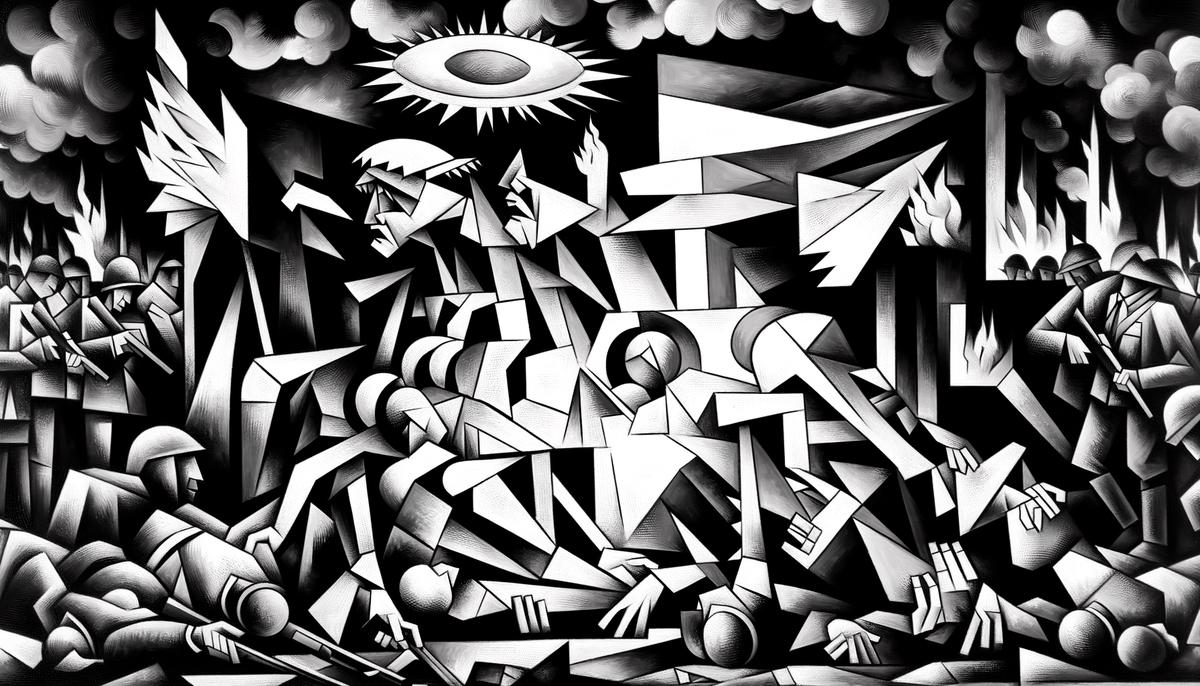
Immediate Public Response to ‘Guernica’
Upon its debut in 1937, ‘Guernica’, the arresting masterpiece by Pablo Picasso, generated a profound constellation of emotional and cognitive responses. Rendered in stark monochromatic hues, the canvas conveyed the harrowing aftermath of the Luftwaffe’s assault, capturing the world’s attention and becoming a lodestar for anti-war sentiment.
The initial public encounter with ‘Guernica’ was marked by an immersive impact that surpassed mere visual stimulation, engendering a visceral experience of the civilian agony sustained during the bombardment. Spectators were confronted with a pantheon of tortured figures: a grieving woman clutching her deceased child, a fallen soldier dismembered, and a petrified horse screaming in agony, among others. These symbolic representations catalysed a wave of empathy, situating viewers within the emotional truth of the human condition when besieged by war.
Cognitively, the artwork compelled individuals to engage in an introspective journey, fostering a meditation on the consequences of totalitarian aggression and the cost of political apathy. It prompted intellectual discourse on the ethics of warfare, the responsibilities of international bystanders, and the role of art as a medium for social commentary and historical testimony. The piece defied traditional aesthetic sensibilities, employing its disjointed and abstracted forms not for decoration but as a stark mnemonic device, urging remembrance and cognisance of the atrocities inflicted.
Among intellectuals and art critics, ‘Guernica’ was a fulcrum for debate on modern art’s capacity to encapsulate and communicate complex societal issues. The painting was regarded as a pivotal narrative tool that transcended language barriers, enabling it to resonate across a variegated audience. Critics discerned in its universal language a powerful indictment of war, which could be understood and felt, irrespective of political or cultural allegiance.
In sum, the unveiling of ‘Guernica’ was not merely a historical moment but a transformative one, calling forth an array of emotions from revulsion to sorrow and a breadth of thoughts from contemplation on the human cost of war to the redemptive power of artistic expression. It stands as a testament to the strength of visual art in challenging the observer, awakening consciousness, and preserving the dignity of those voices silenced by conflict. In doing so, ‘Guernica’ has cemented its place not solely as a pinnacle of Picasso’s artistic career but as an eternal sentinel against the peril of oblivion.
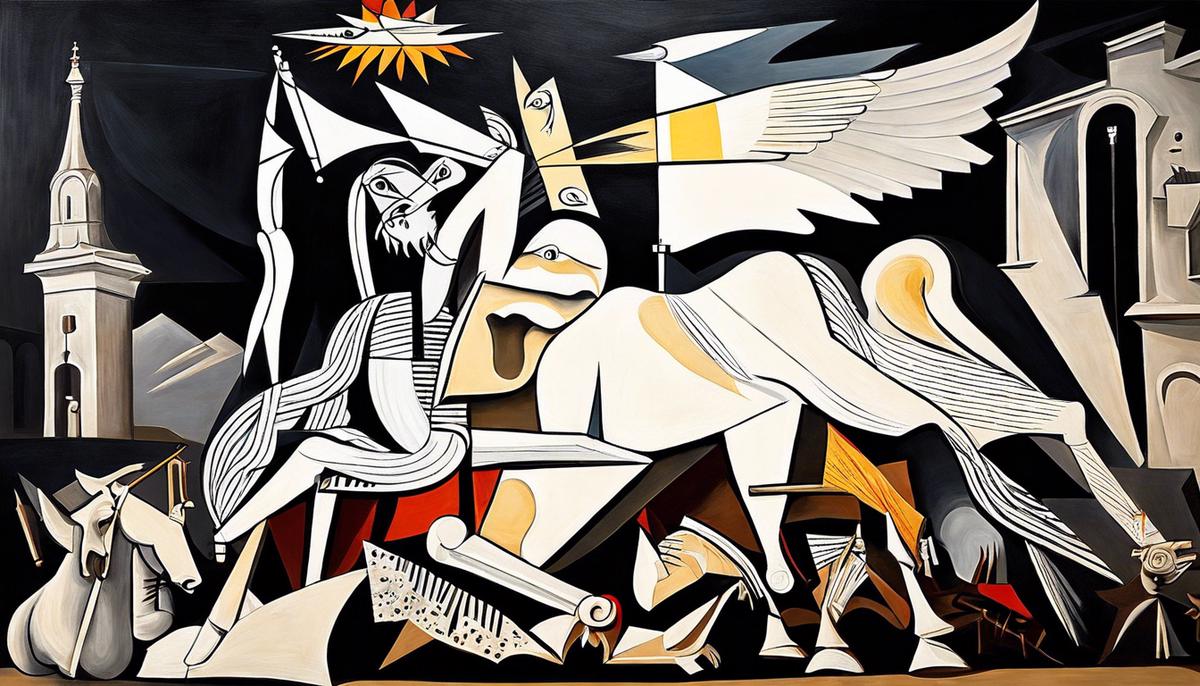
Art Critic and Scholarly Analysis of ‘Guernica’
Upon its unveiling, ‘Guernica’ by Pablo Picasso elicited a torrent of intellectual scrutiny from art critics and scholars alike. The enormity of insight into the symbolism and technical merit of this masterpiece is vast and cannot be overstated, worthy of the rigorous contemplation it has garnered.
Expert analysis has dissected ‘Guernica’s’ morass of human, animal, and inanimate representations as an allegory for the rampant destruction wrought by the aerial bombardment. The harrowed figures within the painting – a grieving mother, a fallen soldier, a terrified horse – are often interpreted as symbols of the disjointed and fractured existence wrought by violence. Critics have been keen to point out that unlike traditional war portrayals that might romanticize or sanitize conflict, ‘Guernica’ confronts the observer with visceral and immediate horrors.
The technical aspects of ‘Guernica’ have also been closely examined. The painting’s monochromatic palette, utilizing stark blacks, whites, and greys, harmonizes with its grave subject matter and echoes the black-and-white newsreels of the era. This has led to suggestions that Picasso sought to create a timeless quality, ensuring the painting’s message transcends specific historical moments. In contrast to the monochrome is the chaotic composition; scholars remark on the spatial disorientation within ‘Guernica’, perhaps intending to evoke the pandemonium of war.
The rendering of light and shadow in the composition, too, has not eluded academic commentary. The light bulb at the apex of the scene has been variously interpreted – as an eye overlooking the destruction, a bomb detonating, or even representing the light of truth amidst darkness. Each interpretation deepens the narrative, and this element of the oeuvre substantiates debates among scholars regarding the layers of meaning Picasso imbedded within his work.
Moreover, the marked absence of colour is not only a testament to the bleak subject matter but also signifies a departure from Picasso’s previous stylistic tendencies. This stark contrast elucidates an intent to disrupt, which many scholars believe is a deliberate technical choice designed to mirror the disruption of peace and life in Guernica.
Within the annals of art criticism, ‘Guernica’ has also been credited with redefining the potential of cubism, as its angular fragmentation helps convey the dismemberment of society and corporeality. The use of distorted figures and broken perspectives, contributing to a narrative that is symbolically and emotionally rich, has solidified ‘Guernica’ as a seminal work in the discourse on modernist techniques and their expressive capabilities.
‘Guernica’s’ unveiling unlocked a dialogue about the potency and responsibilities of the artist in times of social upheaval. Picasso’s synthesis of innovative technique and profound commentary continues to provide fertile ground for academic exploration, and argues ever so convincingly, that art can, indeed, bear witness. The interrogation of ‘Guernica’ by art critics and scholars has not only deepened the understanding of this individual work but has forever altered the conversation about the interplay between art, politics, and human emotion.
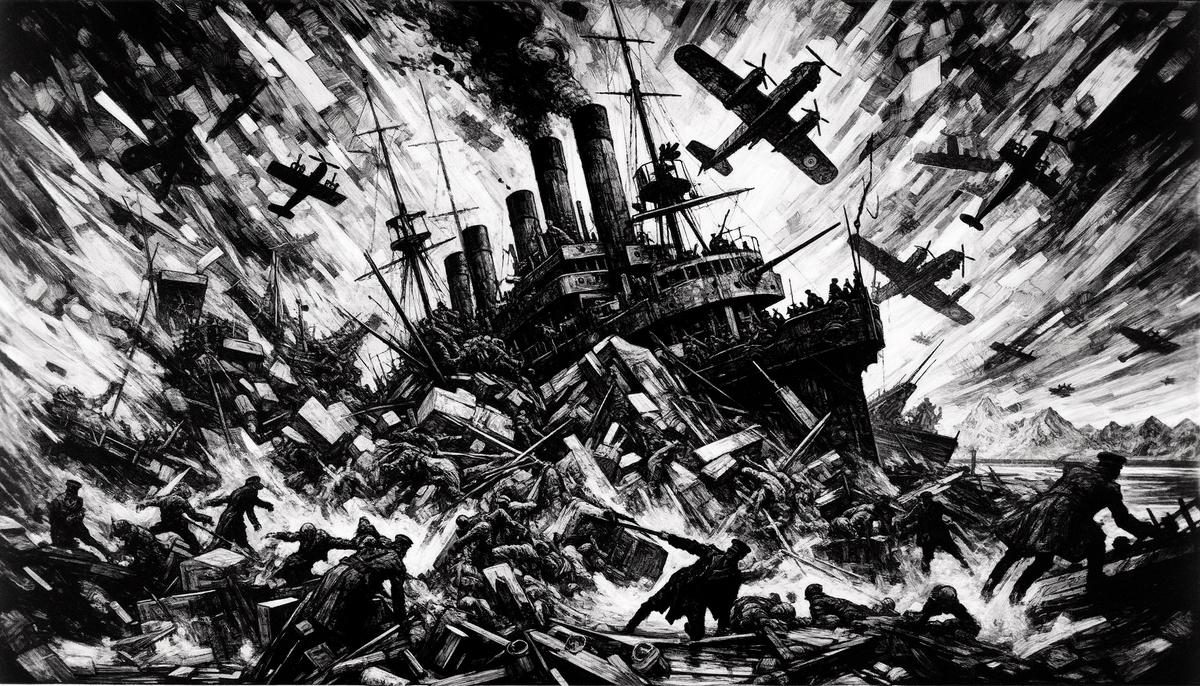
Long-Term Influences on Art and Culture
In the annals of artistic mastery, ‘Guernica’ by Pablo Picasso stands as a formidable influence on subsequent generations of artists and cultural discourse. This masterwork, far beyond its initial exhibition, catalyzed a profound shift in the artistic landscape, integrating the stark realities of human conflict with the expressive capacity of visual art.
Evolving from Picasso’s canvas, the powerful imagery of ‘Guernica’ emboldened other artists to embrace art as an arena for powerful political statement and societal critique. It carved a path for the emergence of a genre of politically engaged art that found its roots in the turbulence of human atrocities, thus breaking the confines of aesthetic formality and transforming art into an active participant in cultural dialogue.
Moreover, Picasso’s ‘Guernica’ reinvigorated the debate over the boundary between aesthetics and utility in art. It elevated the importance of content, symbolism, and intentionality, eroding rigid definitional barriers and encouraging flexibility in the interpretation of artistic work.
In the domain of education and curatorship, ‘Guernica’s impact is palpable. It became a focal point for pedagogical approaches that aim to amalgamate historical context with visual literacy. Museums and galleries around the world use the painting as a central piece from which dialogues about war, peace, and historical memory radiate, delving into the irrevocable bond between past and present, the creative and the didactic.
The gravity of Picasso’s work also manifestly influenced the arena of transnational cultural exchange. As the world moved through turbulent periods riven with conflict, ‘Guernica’ served as a universal reference, a touchstone for understanding the strife and struggle endemic to the human condition. Its language of anguish and despair, encapsulated in the disfigured forms and the agonizing expressions of its figures, transcends linguistic boundaries, fostering empathy and understanding across diverse populations.
In the field of artistic development, the force of ‘Guernica’ instigated the exploration of new materials and methods. Artists found inspiration in Picasso’s technique, engaging with the canvas in a manner that prioritized emotional resonance and raw communication over conventional forms of beauty. The piece’s monumental scale and unorthodox use of negative space enlightened practitioners to the potential emotional impact of physical presence and absence within a composition.
Lastly, ‘Guernica’ reshaped cultural dialogues pertaining to the ethics of representation. The question of how, or indeed whether, one can portray such profound human suffering without exploitation or sensationalism was brought to the forefront of academic and artistic scrutiny. Picasso’s treatment of the subject matter established a moral compass that guided future endeavors to use art not merely as a reflection of reality, but as a conscientious contributor to the narrative of human experience.
In summation, ‘Guernica’s shadow extends far beyond the edges of its frame, becoming an ascendant precedent in the intimate entwining of art and societal consciousness, constantly redefining the parameters of cultural pursuit and enlightenment.
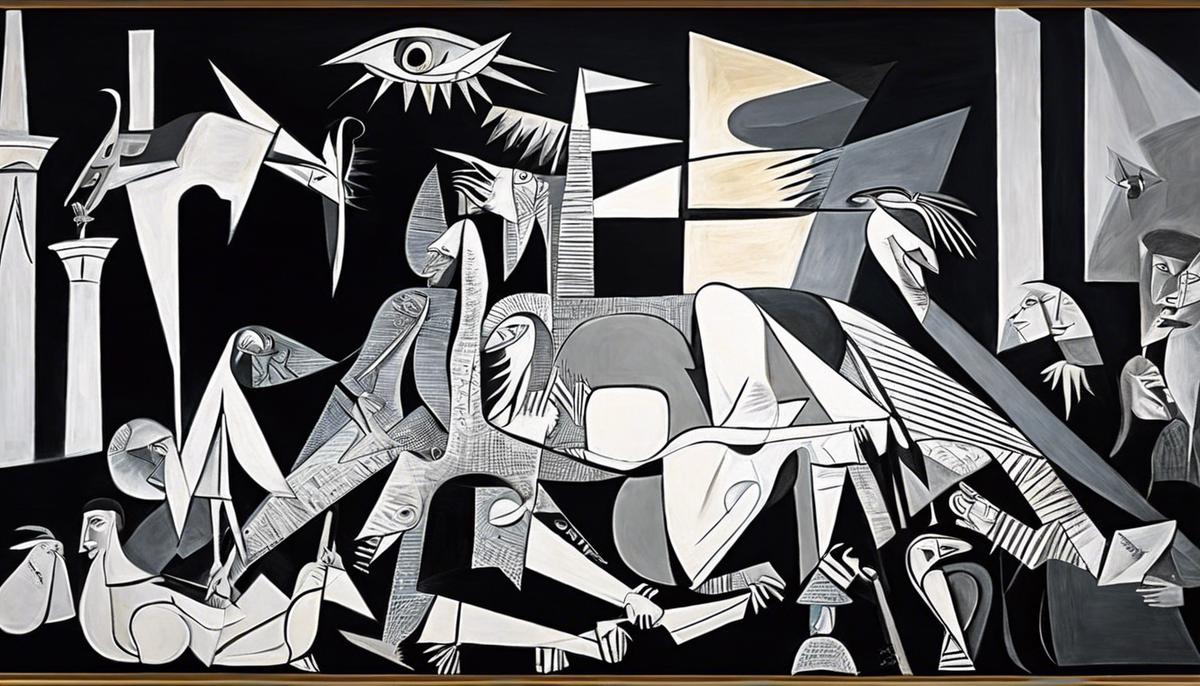
The Evolution of Public Perception of ‘Guernica’
Public perception of ‘Guernica’ has undergone a notable evolution since its initial unveiling up to the contemporary era. Initially conceived as an immediate artistic reaction to a wartime atrocity, the painting transcended its immediate historical moment to become an enduring icon. In the contemporary perspective, ‘Guernica’ serves not merely as historical testimony but also as an evergreen reminder of the tragedies of warfare, prompting ongoing dialogue on the human condition.
The narrative woven through ‘Guernica’ has been subject to diverse interpretations facilitated by its journey across the world. Once confined predominantly to the realms of academia and the cognoscenti, its dialogue now encompasses a broader, more inclusive audience. As the painting toured globally, each exhibit became a canvass for public engagement, with interpretations reflecting the zeitgeist of each era.
In the wake of the Second World War, ‘Guernica’ stood as a grim premonition of the global conflict that unfolded shortly after its creation, bolstering its reputation as an anti-war symbol. Subsequent generations viewing the painting found resonance in its visual language amid the backdrop of their own societal and political struggles, such as the Vietnam War and various civil rights movements.
In Spain itself, the transition to democracy – following the lengthy dictatorship that suppressed expressions of regional identity – compounded ‘Guernica’s’ significance. The painting evolved into a poignant representation of freedom and a catalyst for reconciliation with the nation’s past. Its long-awaited repatriation in 1981 marked a milestone in Spain’s cultural and democratic restoration.
Moreover, the ascent of mass media, and subsequently digital media, has broadened the accessibility of ‘Guernica’, allowing it to permeate public consciousness like never before. The emergence of the internet and social media platforms facilitates virtual access to the painting, inciting discussions and interpretations among demographics previously unacquainted with Picasso’s masterpiece.
Current evaluations often focus on the interplay between the aesthetics of ‘Guernica’ and its political resonance in today’s fragmented world. Acknowledging the work’s historical context, contemporary critics and viewers are increasingly discerning the need for artworks that confront and articulate collective traumas. Thus, ‘Guernica’ has come to symbolize the enduring power of art to bear witness and effect change across generations and geographies.
Furthermore, ‘Guernica’s’ utilisation in education curricula and scholarly studies underscores its significance as an educational tool for fostering critical engagement with history, politics, and ethics. It remains instrumental in introducing seminal discussions on the capacity of art to document and provoke reaction to the complexities of human experience.
In conclusion, the public perception of ‘Guernica’ has transitioned from an emblem of wartime protest to a multifaceted symbol of universal humanity. Its trajectory reflects the changing tides of political climates and cultural discourses, yet its core message, that of an unyielding denouncement of violence and a passionate plea for peace, remains strikingly relevant even as we grapple with contemporary conflicts and humanitarian crises. Through its persistence in public memory and discourse, ‘Guernica’ endures, eternally relevant in a world still bedevilled by the shadows of war.
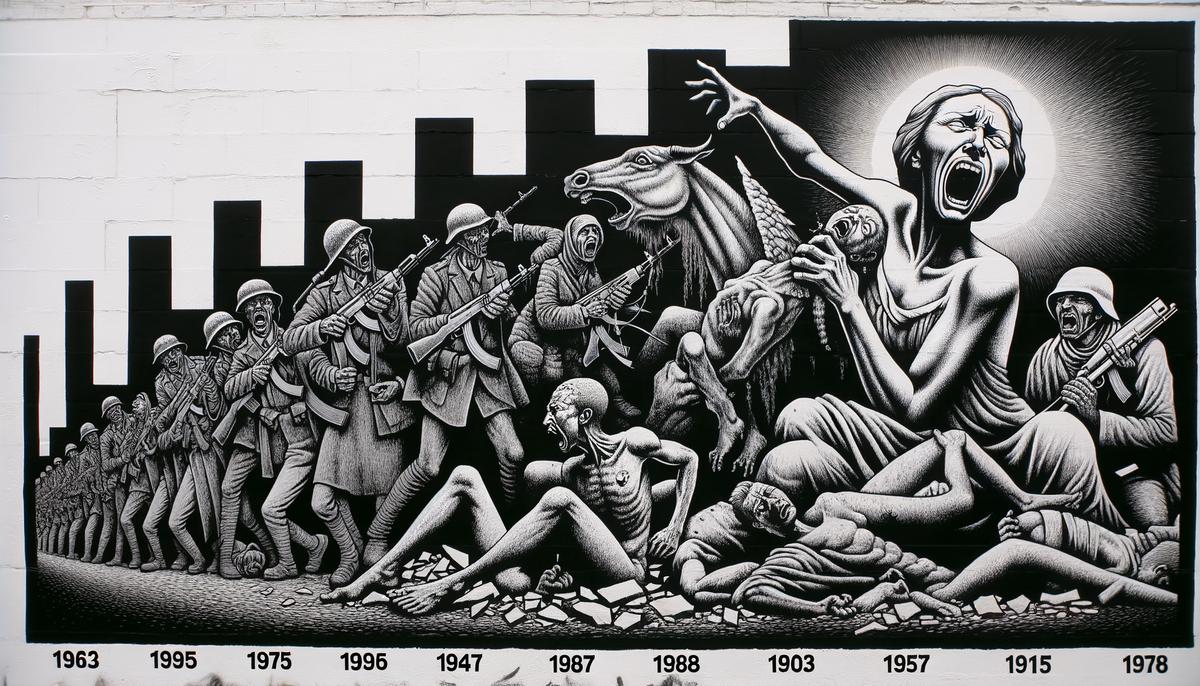
The dialogue between Pablo Picasso’s ‘Guernica’ and the public domain continues to be as evocative as the day the canvas was first unfurled before the eyes of a bewildered world. Over the decades, the narrative woven through its cubist forms and monochromatic tableau has matured, transforming from an emblem of specific historical anguish to a universal symbol of peace and a clarion call against the perpetuity of war. With each passing era, ‘Guernica’ embarks on a new chapter of cultural significance, its longevity a testament to the unwavering resonance of art in the face of humanity’s most profound tribulations.





















